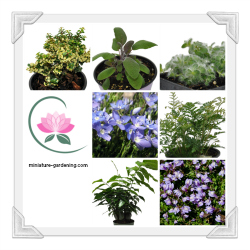What is Growing in Your Fairy Garden?
Spring has offi cially sprung in the miniature garden! The snow has melted away, the ground has thawed, and tiny shoots of green are beginning to appear amidst the miniature houses and fairy garden accessories. Come springtime, and there can be all sorts of things growing in your miniature garden, from last year’s plants to pesky weeds to visiting seeds that have blown other from nearby yards and trees. Now is the time to dust off the gardening gloves and dive back into the fairy garden plants and miniature trees that we all love so much. Are you considering a fresh style or theme for your fairy garden? Are you hoping to have an even more robust mix of interesting miniature plants this year? Spring is a time of possibility. Check out some of my new favorites for a few ideas and start the creative gardening juices flowing.
cially sprung in the miniature garden! The snow has melted away, the ground has thawed, and tiny shoots of green are beginning to appear amidst the miniature houses and fairy garden accessories. Come springtime, and there can be all sorts of things growing in your miniature garden, from last year’s plants to pesky weeds to visiting seeds that have blown other from nearby yards and trees. Now is the time to dust off the gardening gloves and dive back into the fairy garden plants and miniature trees that we all love so much. Are you considering a fresh style or theme for your fairy garden? Are you hoping to have an even more robust mix of interesting miniature plants this year? Spring is a time of possibility. Check out some of my new favorites for a few ideas and start the creative gardening juices flowing.
Fun with Ferns
Ferns are some of the most delicate and feathery miniature plant additions to the fairy garden. Their thin stems and leaves may have their fairy-like texture, but they can grow tall and wide, showing off in the fairy garden and creating a green cover for the magical garden. Davallia fejeensis ‘Rabbits Foot Fern’ is a particularly interesting variety, as it grows creeping rhizomes from the bottom of the plant. Their unique, hairy texture adds an unexpected element to the garden.
Fairy Flowers
Outdoor miniature gardens can significantly benefit from ground cover plants. Ground covers help choke out weeds, work well on tricky slopes, and often provide a colorful blanket of flowers in which garden fairies can frolic and play! Low-growing ground covers are an alternative to grass, gravel, and other landscaping choices. For flowers in a lovely lavender color that fairies will appreciate, look for Mazus reptans ‘Creeping Mazus’ or Veronica oltensis ‘Creeping Thyme Leaf.’ The latter choice is a little smaller, which is great for filling in cracks and adding details. Mazus reptans can brighten up an entire yard.
Little Leaves
When you are working with fairy garden accessories and small-scale gardens, it can be fun to find miniature plants with teeny-tiny leaves. To the fairies and other small residents of your miniature garden, these leaves would probably appear life-size. When scaling the smallest of plants for fairy gardens and other miniature gardens, one of our favorites is Ilex crenata ‘Jersey Jewel.’ Its popular moniker is ‘Japanese Holly.’ This fairy garden plant is a small shrub that grows both tall and wide. Its deep-toned green leaves grow densely throughout the plant’s branches; they are about the size of a fingernail, or even smaller. Imagine what the leaves would look like to a garden fairy!
Another plant with similarly small leaves is Cerastium alpinum lanatum ‘Alpine Mouse Ear.’ This plant’s “ears” are small, rounded, fuzzy leaves in a silver-gray color that is altogether magical. Easy to care for, ‘Mouse Ears’ is drought resistant and features little white flowers - a prim and proper choice for the tiniest of fairy garden residents.
Majestic Growers
Finally, if you like to play with size and scale in your fairy garden and are looking for some very tall or wide plants that will make a striking scene next to a miniature house or other fairy garden accessory, we have got you covered. A longtime favorite, the Sansevieria cylindrical ‘Snake Plant’ is known as a hardy houseplant with pointy, spear-like tips that grow vertically. Just imagine the pixies playing hide-and-go-seek between these tall tendrils, or unicorns galloping through a “forest” of snake plant spears! Other standouts are Castanospermum austral ‘Lucky Bean Plant’ with its green canopy of leaves that grow tall and spread wide, as well as Ophiopogon nigrescens ‘Black Mondo Grass’ with its clumps of grass-like leaves in a dark color that is a grand fit for dark, mysterious, and magical gardens.
When you are choosing fairy garden plants to establish in your miniature garden consider plant zones, light requirements, and care demands before purchasing the plants. Take time to design which plants will look best next to each other and the amount of growing space required for a mature plant. Finally, sprinkle fairy garden accessories amidst the greenery and flowers. Have fun, enjoy the journey, and (as always)—happy gardening!
Comments
{{ errors.first("comment") }}

